Design Discussion and Conceptual Development Strategies for Azimpur Govt. Housing Redesign
Designing a residential high-rise complex with a central community and a canal-like waterbody that provides equal views to each high-rise unit can be challenging. However, it can be achieved with careful planning and consideration for sustainable and green architectural features.
SUSTAINABLE LIVING
Muhammad Golam Sami
2/15/20237 min read
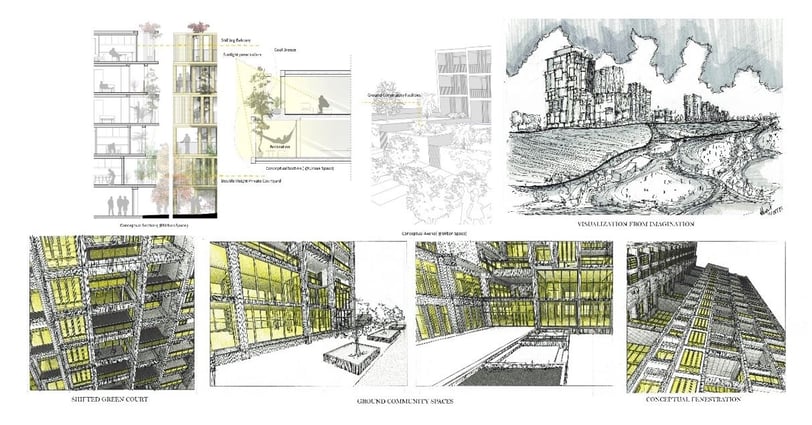

Image: Conceptual development of the renovation of Azimpur Govt, Housing, Dhaka-1205 by Muhammad Golam Sami
Designing a residential high-rise complex with a central community and a canal-like waterbody that provides equal views to each high-rise unit can be a challenging task. However, with careful planning and consideration for sustainable and green architectural features, it can be achieved.
The first step is to locate the waterbody in the center of the complex, with the high-rise buildings surrounding it. This will provide a central focus point for the community, as well as an aesthetically pleasing view from each unit. The waterbody could be designed as a meandering stream, with landscaped gardens and walking paths along its banks.
To ensure that each high-rise unit has an equal view of the waterbody, the buildings can be designed staggered or stepped. This means that the buildings are not lined up directly behind each other but instead are offset slightly to provide an unobstructed view.
The architecture of the buildings can also incorporate sustainable and green features such as energy-efficient windows, green roofs, solar panels, and rainwater harvesting systems. The buildings could be designed to maximize natural light and ventilation, reducing the need for artificial lighting and air conditioning.
In addition to the central waterbody, the complex could also feature communal gardens and green spaces, providing a natural sanctuary for residents to relax and unwind. The landscaping could incorporate native plants and trees, reducing the need for excessive watering and maintenance.
The complex could provide bicycle storage and charging stations for electric vehicles to encourage sustainable transportation. The buildings could also be designed with easy access to public transit, reducing the need for personal vehicles.
Overall, designing a residential high-rise complex with a central community and waterbody can provide residents an attractive and sustainable living environment. With careful planning and consideration for green architectural features, the complex can also have a minimal environmental impact, making it an ideal choice for those who value sustainability and community living.
1 . Accessibility Design:
Designing a high-rise housing cluster with private and public recreation areas that are seamlessly connected, have inclusion, and public-private zoning requires careful planning and consideration of architectural features. Here are some features that can help achieve this goal:
Bicycle and Pedestrian Track: The front yard of the high-rise housing cluster can be designed to have a bicycle and pedestrian track, which can connect the public recreation facilities and the private backyards. This will provide a safe and convenient way for residents to move between the two zones.
Continuity: The design of the front yard waterbody should be continuous, with the public recreation facilities surrounding it. This will ensure that every high-rise unit has an equal view of the water body and creates a central gathering place for the community.
Inclusion: To promote inclusion, public recreation facilities should offer a range of amenities that cater to different age groups and interests. For example, there could be areas for children to play, outdoor exercise equipment for adults, and seating areas for seniors.
Public-Private Zoning: The private backyards and the public recreation facilities should be zoned separately, with clear boundaries to ensure privacy and security for residents. Fencing can be used to separate the two zones while maintaining a visual connection.
Landscaping: Landscaping can be used to define the boundaries between the public and private zones and create a sense of privacy for the backyards. The front yard can be landscaped with greenery, trees, and water features to create a serene and relaxing environment.
Amenities: In addition to the public recreation facilities, private backyards can also have amenities like BBQ areas, swimming pools, and outdoor seating areas. These amenities can be designed to promote privacy and relaxation for residents.
Overall, the design of a high-rise housing cluster with private and public recreation areas requires careful planning and consideration of architectural features. The design should promote inclusion, public-private zoning, and seamless connectivity between the two zones.
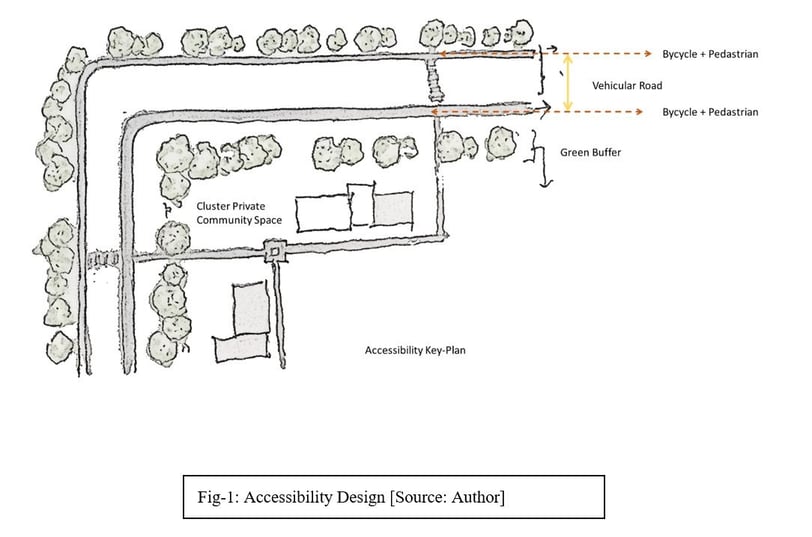

2 . Conceptual Continuity:
The continuous development of low-rise housing to high-rise housing while maintaining the courtyard features and incorporating sustainable approaches requires careful architectural planning principles. Here are some approaches that can be used to achieve this:
Vertical Courtyards: High-rise buildings can incorporate vertical courtyards that bring natural light and fresh air into the building. These can be designed with greenery and water features to create a relaxing and peaceful environment.
Green Roofs: Green roofs can be incorporated into the design of high-rise buildings to improve energy efficiency and provide natural insulation. These can also help mitigate the urban heat island effect and improve air quality.
Passive Design: Passive design strategies can be incorporated into the building design to reduce energy consumption and improve indoor air quality. This includes features like natural ventilation, shading, and high-performance insulation.
Mixed-Use Development: Mixed-use development can be incorporated into the design to increase population density and create vibrant communities. This includes incorporating amenities, shop and residential spaces in the same building.
Sustainable Materials: Sustainable materials can be used in the construction of high-rise buildings to reduce the environmental impact of the construction process. This includes using recycled materials, low-emitting materials, and locally sourced materials.
Water Conservation: Water conservation strategies can be incorporated into the design to reduce water consumption and improve water quality. This includes using low-flow fixtures, rainwater harvesting, and wastewater recycling.
Active Transportation: Active transportation options can be incorporated into the design to promote sustainable mobility. This includes incorporating bike storage, bike-sharing programs, and pedestrian-friendly design.
Overall, the continuous development of low-rise housing to high-rise housing with sustainable approaches requires a holistic approach to architectural planning principles. Incorporating green features, passive design, mixed-use development, sustainable materials, water conservation, and active transportation can help create sustainable and livable communities in high-rise buildings.
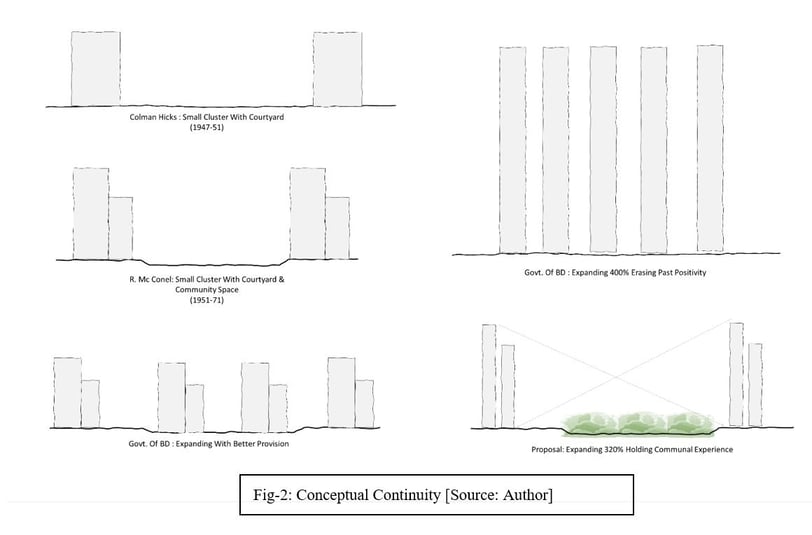

3 . Vehicular Accessibilities:
To ensure continuous and non-distractive internal pedestrian and recreational space in a high-rise housing complex, peripheral vehicular accessibilities can be incorporated into the architectural housing planning. Here are some approaches that can be used to achieve this:
Peripheral Parking: Parking can be located on the periphery of the high-rise housing complex, away from the pedestrian and recreational areas. This will reduce vehicular traffic within the complex and create a safer and more peaceful environment for residents.
Pedestrian Walkways: Pedestrian walkways can be designed to connect the peripheral parking areas to the high-rise housing complex. These can be designed to be wide and well-lit, with greenery and seating areas to create a welcoming and relaxing environment.
Drop-Off Zones: Drop-off zones can be located at the entrances to the high-rise housing complex to provide convenient access for residents and visitors. These can be designed with seating areas and landscaping to create a welcoming and attractive entrance.
Service Entrances: Service entrances can be located on the periphery of the high-rise housing complex, away from the main pedestrian and recreational areas. This will reduce disturbance to residents and maintain a peaceful environment within the complex.
Bicycle Storage: Bicycle storage can be incorporated into the peripheral parking areas, with convenient access to the pedestrian walkways. This will encourage residents to use active transportation and reduce vehicular traffic within the complex.
Overall, incorporating peripheral vehicular accessibilities into the architectural housing planning can help create a safe and peaceful environment for residents, with continuous and non-distractive internal pedestrian and recreational space. This includes peripheral parking, pedestrian walkways, drop-off zones, service entrances, and bicycle storage.
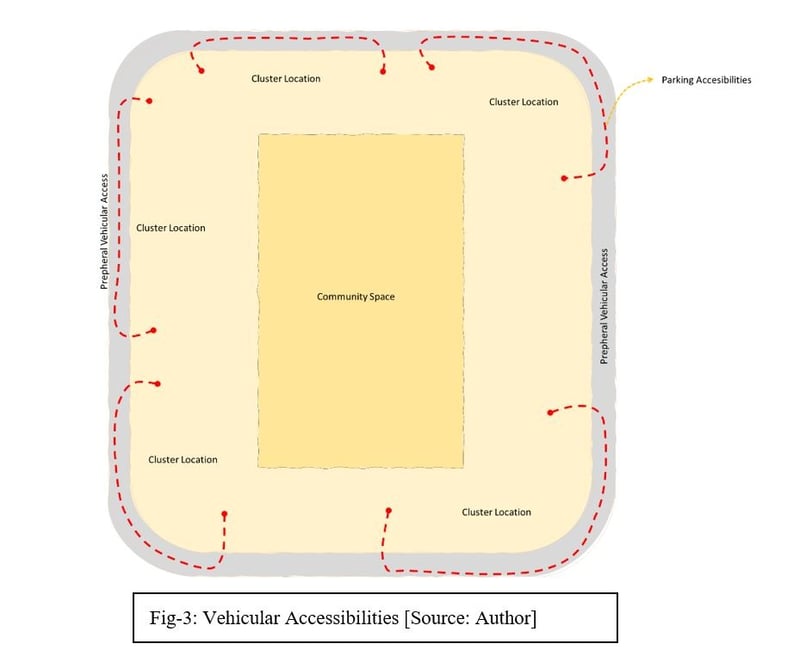

4 . Ultimate Conceptualization ( Functional & Visual):
A high-rise residential housing complex with a vertically shifted double-height green courtyard and garden, vertical community space distribution, maximum light penetration, waterbody evapotranspiration, and proper climatic solutions can create a sustainable and livable environment for residents. Here are some architectural features that can be incorporated into the design to achieve this:
Vertical Shifted Double-Height Green Courtyard: The housing complex can incorporate a vertical shifted double-height green courtyard that brings natural light and fresh air into the building. This can be designed with greenery and water features to create a relaxing and peaceful environment for residents.
Vertical Community Space Distribution: The community spaces can be distributed vertically throughout the building to promote social interaction and a sense of community among residents. These can include common areas like rooftop gardens, lounges, and fitness facilities.
Maximum Light Penetration: The building design can prioritize maximum light penetration by incorporating features like large windows and open floor plans. This will allow natural light to penetrate deep into the building, reducing the need for artificial lighting and improving the living environment for residents.
Waterbody Evapotranspiration: A waterbody can be incorporated into the design of the housing complex to promote evapotranspiration and cool the surrounding environment. This can be designed with water features like fountains, streams, and ponds to create a peaceful and relaxing environment for residents.
Proper Climatic Solutions: Proper climatic solutions can be incorporated into the design to reduce energy consumption and improve indoor air quality. This includes features like natural ventilation, shading, and high-performance insulation to reduce the need for heating and cooling.
Overall, incorporating a vertically shifted double-height green courtyard and garden, vertical community space distribution, maximum light penetration, waterbody evapotranspiration, and proper climatic solutions can create a sustainable and livable environment for residents in a high-rise residential housing complex. These architectural features promote social interaction, reduce energy consumption, and improve the overall quality of life for residents.
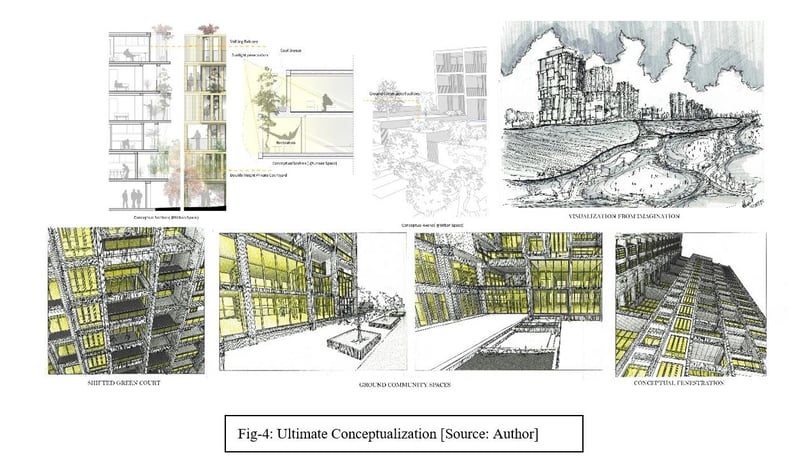

Meet The Author
Related ARTICLES
Related PROJECTS
Revising The Renovation of Azimpur Govt. Housing , Dhaka - 1205
This project aims to provide a friendly framework for the future renovation or regeneration of these housing units in Bangladesh, taking into account the climatic and social factors that compel them to analyze the past, present, and future effects of this radical change in government housing, along with providing a structured policy for establishing government prototypes that enable government housing projects to be more sustainable and eliminate adverse effects.
Image: Azimpur Govt. Housing Renovation Visual at Bird's Eye
Location: Dhaka-1205; Year: 2023






